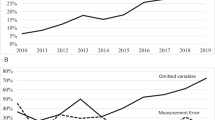Abstract
We analyse determinants of the wage differentials observed between thirteen European countries using the European Community Household Panel (ECHP). The empirical decomposition is based on a proportional hazards model. The approach based on rank invariant estimators is borrowed from the literature on failure time data and has been adapted by Donald et al. (Rev Econ Stud 67:609–633, 2000) to analyse differences in wage distributions. Extending this approach and using natural splines to allow for nonlinear regression effects we isolate three different underlying forces for wage differentials: differences in characteristics, differences in weights of characteristics and differences in the returns-to-skill functions. The analysis reveals that country differences in returns-to-skill functions contribute most to observed wage differences while differences in observed characteristics contribute surprisingly little.
Similar content being viewed by others
References
Aaberge, R., Bjerve, S., Doksum, K.: Modeling inequality and spread in multiple regression. In: 2nd Lehmann Symposium - Optimality. IMS Lecture Notes - Monograph Series, vol. 49, pp. 120–130 (2006)
Andini, C.: Within-groups wage inequality and schooling: further evidence for Portugal. IZA discussion paper 2828 (2007)
Beaudry, P., Green, D.A.: Wages and employment in the United States and Germany: what explains the difference? Am. Econ. Rev. 93, 573–602 (2003)
Beblo, M., Beninger, D., Heinze, A., Laisney, F.: Methodological issues related to the analysis of gender gaps in employment, earnings and career progression. http://europa.eu.int/comm/employment_social/employment_analysis/gender/gender_fin_rep.pdf (2003)
Behr, A.: Comparing estimation strategies in the presence of panel attrition. Empirical results based on the ECHP. J. Econ. Stat. 226, 361–384 (2006)
Behr, A., Bellgardt, E., Rendtel, U.: Extent and determinants of panel attrition in the European community household panel. Eur. Sociol. Rev. 21, 489–512 (2005)
Blau, F.D., Kahn, L.M.: Wage structure and gender earnings differentials: an international comparison. Economica, 63, S29–S62 (1996)
Blau, F.D., Kahn, L.M.: Understanding international differences in the gender pay gap. J. Labor Econ. 21, 106–144 (2003)
Dabrowska, D.M.: Quantile regression in transformation models. Sankhyā 67, 153–186 (2005)
DiNardo, J., Lemieux, T.: Diverging male wage inequality in the United States and Canada, 1981-1988: do institutions explain the difference? Ind. Labor Relat. Rev. 50, 629–651 (1997)
DiNardo, J., Fortin, N., Lemieux, T.: Labor market institutions and the distribution of wages, 1973–1992: a semiparametric approach. Econometrica 64, 1001–1044 (1996)
Donald, S., Green, D.A., Paarsch, H.J.: Differences in wage distributions between Canada and the United States: an application of a flexible estimator of distribution functions on the presence of covariates. Rev. Econ. Stud. 67, 609–633 (2000)
Fleming, T.R., Harrington, D.P.: Counting Processes & Survival Analysis. Wiley (1991)
Fortin, N.M., Lemieux, T.: Rank regressions, wage distributions, and the gender gap. J. Hum. Resour. 33, 610–643 (1998)
Hettmansperger, T.P.: Statistical Inference Based on Ranks. Wiley (1984)
Juhn, C., Murphy, K.M., Pierce, B.: Accounting for the slowdown in black-white convergence. In: Kosters, M.H. (ed.) Workers and Their Wages, pp. 107–143. Washington DC (1991)
Juhn, C., Murphy, K.M., Pierce, B.: Wage inequality and the rise in returns to skill. J. Polit. Econ. 101, 410–442 (1993)
Kalbfleisch, J.D., Prentice, R.L.: Statistical Analysis of Failure Time Data, 2nd edn. Wiley (2002).
Koenker, R.: Quantile Regression. Cambridge University Press (2005)
Machado, J.A.F., Mata, J.: Counterfactual decomposition of changes in wage distributions using quantile regression. J. Appl. Econ. 20, 445–465 (2005)
Martins, P.S., Pereira, P.T.: Does education reduce wage inequality? Quantile regression evidence from 16 countries. Labour Econ. 11, 355–371 (2004)
Peracchi, F.: The European community household panel: a review. Empir. Econ. 27, 63–90 (2002)
Silverman, B.W.: Density Estimation. Chapman and Hall, London (1986)
Solomon, P.J.: Effect of misspecification of regression models in the analysis of survival data. Biometrika 71, 291–298 (1984)
Solomon, P.J.: Effect of misspecification of regression models in the analysis of survival data. Correction, Biometrika 73, 245 (1986)
Struthers, C.A., Kalbfleisch, J.D.: Misspecified proportional hazard models. Biometrika 73, 363–369 (1986)
Author information
Authors and Affiliations
Corresponding author
Electronic Supplementary Material
Below is the link to the electronic supplementary material.
Rights and permissions
About this article
Cite this article
Behr, A., Pötter, U. What determines wage differentials across the EU?. J Econ Inequal 8, 101–120 (2010). https://doi.org/10.1007/s10888-008-9106-z
Received:
Accepted:
Published:
Issue Date:
DOI: https://doi.org/10.1007/s10888-008-9106-z




